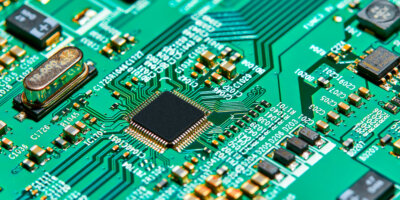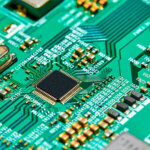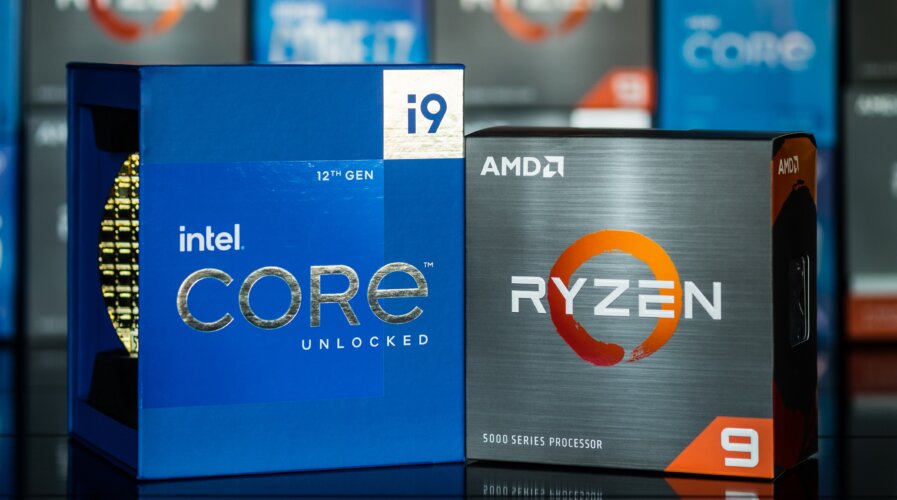
The rise of AI in the personal computing industry. (Source – Shutterstock)
How Intel and AMD are redefining the future of AI in PCs
- AI-enabled PCs mark a significant turning point in personal computing, led by Intel and AMD.
- AMD’s strong performance heralds an AI-driven era in PC innovation.
- The AI PC looks to be in our near future.
As we stand on the cusp of a technological renaissance, the personal computer industry, once perceived as heading towards stagnation, is experiencing a revival of fortune and innovation. Intel and AMD, the stalwarts of this sector, have not only signaled a robust recovery in the PC market but are leading the charge into a bold new era marked by the advent of AI in personal computing.
This rejuvenation, hinted at through their recent earnings, is more than just a fleeting rebound; it heralds a transformative shift in how we interact with technology.
At the heart of this resurgence are the insights shared by Intel CEO Pat Gelsinger and AMD CEO Lisa Su. Both visionaries underscore the stabilizing PC market and foresee the integration of AI as a pivotal catalyst for growth. The concept of AI-enabled PCs – machines equipped with advanced chips capable of running sophisticated large-language models and applications natively, marks a paradigm shift from cloud-based to local AI computations.
This leap forward not only promises enhanced performance and capabilities, but opens the door to an array of innovations previously thought impractical in a PC environment.
The vision of AMD and Intel for AI in personal computing
Intel CEO Pat Gelsinger remarked, “The arrival of the AI PC represents an inflection point in the PC industry.” Lisa Su of AMD anticipates growth into 2024, aligning it with the new AI PC cycle and upcoming Microsoft Windows updates.
AI-powered PCs, integrated with sophisticated processors capable of independently running large-scale language models and applications, move away from traditional cloud dependency. This development in AI PCs has been prominently featured in Intel’s recent AI PC Acceleration Program.
Reuters reported that in its most recent quarter, AMD’s segment focusing on PCs recorded its best performance in two years, while Intel’s PC division experienced its least rapid decline in revenue in eight quarters.
Justin Sumner, a senior portfolio manager at Voya Investment Management and investor in both AMD and Intel, observed a notable increase in PC demand, attributed to various pandemic-induced factors like remote working.
Sumner noted, “We are finally starting to see a bottoming of this trend. This should lead to a typical inventory refresh and an improvement in the market.”
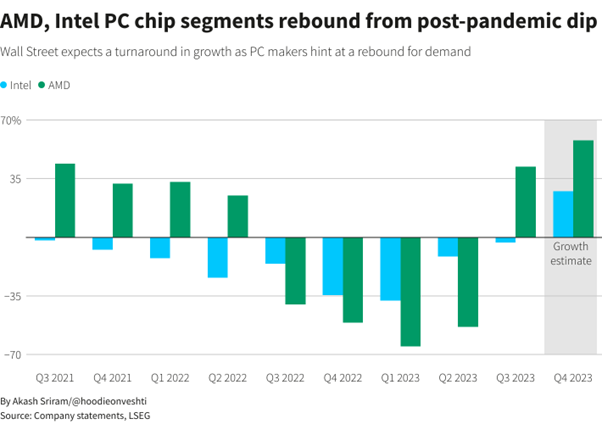
A graph shows AMD and Intel’s chip divisions recover after post-pandemic decline. (Source – Reuters)
Computer manufacturers have been actively reducing their stockpile, anticipating a surge in demand over the holiday season and anticipation of a forthcoming Windows update from Microsoft next year.
Market research from organizations like Canalys bolsters these projections. Following a moderate drop in global PC shipments in the third quarter, Canalys anticipates a return to growth in the market during the eagerly awaited holiday season. They predict a rapid uptake of AI-enabled PCs beginning in 2025, expecting them to comprise approximately 60% of all PC shipments by 2027.
Yet, some investors point out the scarcity of AI applications as a potential obstacle to widespread adoption. Currently, Microsoft is the sole major player offering such technology with its genAI-powered Copilot software, which was launched for Microsoft 365 enterprise clients.
Dave Egan, a senior research analyst at Columbia Threadneedle and investor in both AMD and Intel, said, “It is still unclear to us that there is a “killer app” which will spur this upgrade cycle.”
Dell Technologies and Meta partner for on-premises generative AI with Llama 2
Adding another layer to the AI narrative is the recent partnership between Dell Technologies and Meta. This collaboration aims to simplify the deployment of Meta’s Llama 2 models in Dell customer environments through Dell’s comprehensive generative AI infrastructure, covering IT hardware, client devices, and professional services.
Chris Kelly, senior vice president of data center sales at Dell Technologies for Asia Pacific and Japan, remarked that this integration will enable widespread deployment of generative AI across various locations, with many businesses preferring on-site implementations considering factors like data privacy, security, and the influence of data gravity.
“The integration of Meta’s Llama 2 models into Dell’s generative AI portfolio will help organizations accelerate their digital transformation, enhancing how they engage with customers, employees and the market more broadly, to turn valuable insights into action,” Kelly added.

Deploying Meta’s Llama 2 AI models on-premises. (Source – Shutterstock)
This partnership eases the implementation of AI on-site by merging Dell’s leading infrastructure suite with Meta’s Llama 2 AI models. That lets customers speed up their GenAI projects in traditional data centers or edge locations. Dell’s integration of Meta’s Llama 2 models into their system configuration tools aids clients in selecting optimal solutions for their AI-driven initiatives.
The Dell Validated Design for Generative AI featuring Meta’s Llama 2 offers a comprehensive package of tested Dell infrastructure, software, and services, simplifying the deployment and management of on-site projects. Detailed guidance on setup and configuration allows organizations to quickly establish and predictably operate their GenAI infrastructure.
With the combination of Meta’s Llama 2 and Dell’s wide-ranging generative AI Solutions technology and services, organizations of various sizes can access robust tools, facilitating the delivery of GenAI solutions from personal desktop environments to main data centers, edge locations, and public clouds.
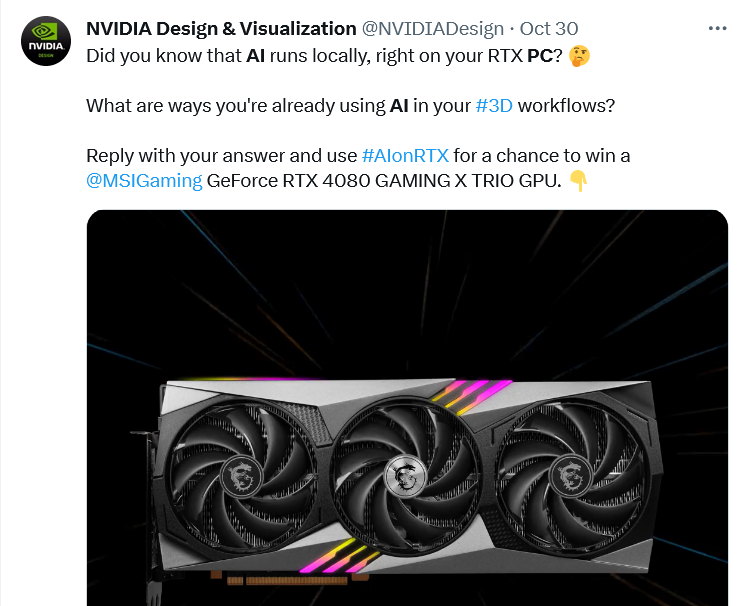
All the big players are focusing on localized AI.
READ MORE
- Safer Automation: How Sophic and Firmus Succeeded in Malaysia with MDEC’s Support
- Privilege granted, not gained: Intelligent authorization for enhanced infrastructure productivity
- Low-Code produces the Proof-of-Possibilities
- New Wearables Enable Staff to Work Faster and Safer
- Experts weigh in on Oracle’s departure from adland

